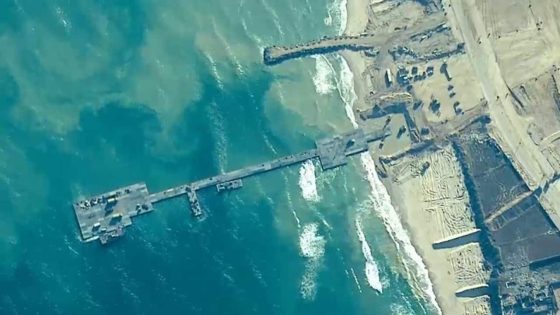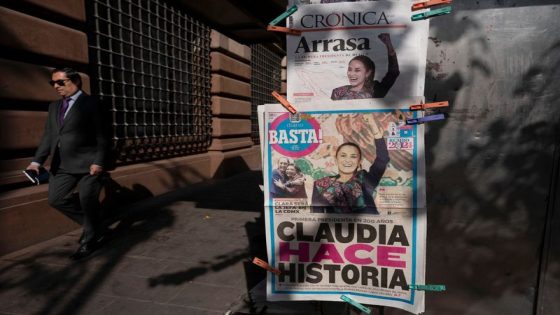Key Points
- The US military said trucks had started moving aid ashore from a temporary pier built off the coast.
- Hamas says US floating aid pier is no substitute for end of Israeli siege of Gaza.
- At least 35,303 Palestinians have now been killed, according to figures from the enclave’s health ministry.
Israeli forces battled Hamas fighters in the narrow alleyways of Jabalia in northern Gaza on Friday in some of the fiercest engagements since they returned to the area a week ago, while in the south militants attacked tanks massing around Rafah.
Residents said Israeli armour had thrust as far as the market at the heart of Jabalia, the largest of Gaza’s eight historic refugee camps, and that bulldozers were demolishing homes and shops in the path of the advance.
“Tanks and planes are wiping out residential districts and markets, shops, restaurants, everything. It is all happening before the one-eyed world,” Ayman Rajab, a resident of western Jabalia, said via a chat app.
Israel had said its forces had cleared Jabalia months earlier in the Gaza war, triggered by the deadly Hamas-led attacks on southern Israel on 7 October, but said last week it was returning to prevent the Islamist group re-grouping there.
At the southern end of Gaza, thick smoke rose over Rafah, bordering Egypt, where an escalating Israeli assault has sent hundreds of thousands of people fleeing from what was one of the few remaining places of refuge.
“People are terrified and they’re trying to get away,” Jens Laerke, UN humanitarian office spokesperson, said in Geneva, adding that most were following orders to move north towards the coast but that there were no safe routes or destinations.
Hundreds of thousands of people are being forced to flee again after around half of Gaza’s population took sanctuary in Rafah after being pushed south by fighting elsewhere. Source: EPA / Mohammed Saber
‘We need access by land now’
As the fighting raged, the US military said trucks had started moving aid ashore from a temporary pier built off the coast, the first to reach the besieged enclave by sea in weeks.
The United Nations said it had finalised plans to distribute the aid, while reiterating that truck convoys by land — disrupted this month by the assault on Rafah — were still the most efficient way of getting aid in.
“To stave off the horrors of famine, we must use the fastest and most obvious route to reach the people of Gaza –- and for that, we need access by land now,” deputy UN spokesperson Farhan Haq said.
Hamas demanded an end to Israel’s siege and accused Washington of complicity with an Israeli policy of “starvation and blockade”.
The White House said US National Security Adviser Jake Sullivan would visit Israel on Sunday and stress the need for an offensive to be targeted at Hamas militants rather than a full-scale assault on Rafah, adding that it was important that Israel open the Rafah border crossing with Egypt immediately.
Humanitarian fears
The Israel Defense Forces (IDF) said troops had killed more than 60 militants in Jabalia in recent days and located a weapons warehouse close to a shelter complex in what it described as a “divisional-level offensive”.
A divisional operation would typically involve several brigades of thousands of troops each, making it one of the biggest of the war.
“The 7th Brigade’s fire control centre directed dozens of airstrikes, eliminated terrorists and destroyed terrorist infrastructure,” the IDF said.
Doctors say they have to perform surgery, including amputations, with no anaesthetics or painkillers as the medical system in the territory has virtually collapsed.
Palestinians pack their belongings as they prepare to flee Rafah in the southern Gaza Strip. Source: Getty / -/AFP via Getty Images
Israel has bombarded Gaza since , according to the Israeli government. More than 35,303 people have been killed in Gaza since 7 October, mostly women and children, according to the health ministry in Gaza.
The 7 October attack was a significant escalation in the.
Israel said on Friday that its forces had retrieved the bodies of three people killed at the Nova music festival in Israel on 7 October and taken into Gaza.
In response, Hamas said negotiations were the only way for Israel to retrieve the hostages alive: “The enemy will not get its prisoners except as lifeless corpses or through an honourable exchange deal for our people and our resistance.”
‘There is a tragic war going on’
Israeli tanks and warplanes bombarded parts of Rafah on Friday, while the armed wings of Hamas and Islamic Jihad said they were firing anti-tank missiles and mortars at forces massing to the east, southeast and inside the Rafah border crossing with Egypt.
, said more than 630,000 people had fled Rafah since the offensive began on 6 May. Many have crowded into Deir al-Balah, a city up the coast that is the only other one in Gaza yet to be assaulted by Israeli forces.
“They’re moving to areas where there is no water – we’ve got to truck it in – and people aren’t getting enough food,” Sam Rose, director of planning at UNRWA, told Reuters on Friday by telephone from Rafah, where he said it was eerily quiet.
, Israeli Justice Ministry official Gilad Noam defended the operation.
Noam said Israel was fighting a war of self-defence and that the military operation in Rafah was not aimed at civilians but at dismantling the last Hamas stronghold.
“There is a tragic war going on, but there is no genocide”, Noam said.
The South African legal team, which set out its case for fresh emergency measures the previous day, framed the Israeli military operation as part of a genocidal plan aimed at bringing about the destruction of the Palestinian people.



